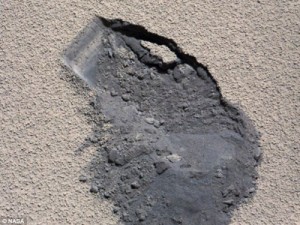Sunday Times 2
Curiosity completes its first analysis of Martian soil
In the first chemical analysis of of minerals on another planet, NASA’s Mars rover Curiosity found soil that bears a striking resemblance to weathered, volcanic sand in Hawaii, scientists have revealed.
The rover uses an X-ray imager to reveal the atomic structures of crystals in the Martian soil, the first time the technology, known as X-ray diffraction, has been used to analyze soil beyond Earth.

This image shows a 'bite mark' where NASA's Curiosity rover scooped up some Martian soil
‘This was a 22-year journey and a magical moment for me,’ NASA’s David Blake, lead scientist for the rover’s mineralogical instrument, told reporters during a conference call.
Curiosity found the Martian sand grains have crystals similar to basaltic soils found in volcanic regions on Earth, like Hawaii.
Scientists plan to use the information about Mars’ minerals to figure out if the planet most like Earth in the solar system could have supported and preserved microbial life.
‘The mineralogy of Mars’ soil has been a source of conjecture until now,’ said Curiosity scientist David Vaniman of the Planetary Science Institute in Tucson, Arizona.
‘This interest isn’t just academic,’ he added. ‘Soils on planets’ surfaces are a reflection of surface exposure processes and history, with information on present and past climates.’
Specifically, scientists want to understand what conditions existed to allow the particular minerals to form.
The first Martian soil scoop is mineralogically similar to basaltic materials and comprised primarily of feldspar, pyroxene and olivine.
About half the soil is non-crystalline materials, like volcanic glass, that form from the breakdown of rocks. The rover is scouting a site where three types of rock intersect. Next year, scientists plan to drive it over to a three-mile (5-km) mound of sediment, named Mount Sharp, rising from the floor of the crater.
‘We’re hopeful that once we get into the truly ancient materials on Mount Sharp, we will find minerals that suggest there was a habitable environment of some kind there.
© Daily Mail, London
Follow @timesonlinelk
comments powered by Disqus























